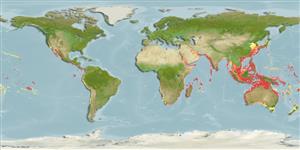Common names from other countries
Environment: milieu / climate zone / depth range / distribution range
Ecología
marino asociado a arrecife; rango de profundidad 18 - 100 m (Ref. 11441). Tropical; 40°N - 40°S, 16°E - 124°W
Indo-West Pacific (Ref. 4919). Lessepsian migrant to the Mediterranean Sea (Ref. 55043).
Length at first maturity / Tamaño / Peso / Age
Maturity: Lm 43.3 range ? - ? cm
Max length : 110 cm TL macho / no sexado; (Ref. 125962); common length : 40.0 cm TL macho / no sexado; (Ref. 5450); peso máximo publicado: 9.0 kg (Ref. 125962)
Short description
Claves de identificación | Morfología | Morfometría
Espinas dorsales (total) : 0; Radios blandos dorsales (total) : 10 - 13; Espinas anales: 0; Radios blandos anales: 8 - 12. Greenish with brown or black spots above; silver band from mouth to caudal fin; belly white; silver blotch in front of eye; pectoral base black (Ref. 4919).
Inhabits offshore reefs (Ref. 9563). Sandy bottom (Ref. 95646). Caught by trammel net (Ref. 96695). This species contains tetrodotoxin which may be a source for food poisoning and the Israel Poison Information center registered 13 cases in December 2008 where all were related to the consumption of this fish (Ref. 118670).
Life cycle and mating behavior
Maturities | Reproducción | Spawnings | Egg(s) | Fecundities | Larva
Masuda, H., K. Amaoka, C. Araga, T. Uyeno and T. Yoshino, 1984. The fishes of the Japanese Archipelago. Vol. 1. Tokai University Press, Tokyo, Japan. 437 p. (text). (Ref. 559)
IUCN Red List Status (Ref. 130435)
CITES (Ref. 128078)
Not Evaluated
Threat to humans
Poisonous to eat (Ref. 559)
Human uses
Pesquerías: sin interés; Acuario: Comercial
Herramientas
Special reports
Download XML
Fuentes de Internet
Estimates based on models
Preferred temperature (Ref.
115969): 21.6 - 28.6, mean 27.3 (based on 762 cells).
Phylogenetic diversity index (Ref.
82804): PD
50 = 0.5005 [Uniqueness, from 0.5 = low to 2.0 = high].
Bayesian length-weight: a=0.01349 (0.01114 - 0.01633), b=2.87 (2.81 - 2.93), in cm Total Length, based on LWR estimates for this species (Ref.
93245).
Nivel trófico (Ref.
69278): 3.7 ±0.4 se; based on diet studies.
Resiliencia (Ref.
120179): Medio, población duplicada en un tiempo mínimo de 1.4-4.4 años (tmax=7; tm=3; K=0.099-0.3;).
Fishing Vulnerability (Ref.
59153): Moderate vulnerability (40 of 100).
